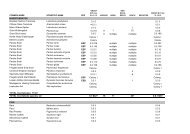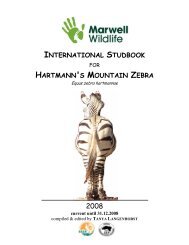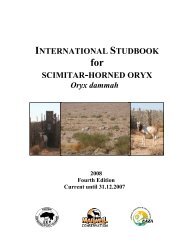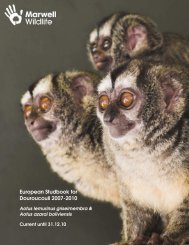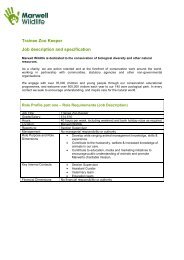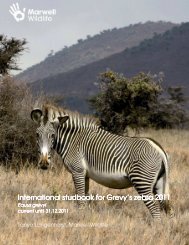Hartmann's mountain zebra studbook 2011 - Marwell Zoo
Hartmann's mountain zebra studbook 2011 - Marwell Zoo
Hartmann's mountain zebra studbook 2011 - Marwell Zoo
Create successful ePaper yourself
Turn your PDF publications into a flip-book with our unique Google optimized e-Paper software.
Mountain <strong>zebra</strong> tracking<br />
The main component of our project involves tracking the movements of wild Hartmann’s <strong>mountain</strong><br />
<strong>zebra</strong>s in Namibia’s Kunene Region. We began this portion of our project by deploying three GPS<br />
collars on <strong>mountain</strong> <strong>zebra</strong>s in July 2010 and March <strong>2011</strong>. These collars have a lifespan of<br />
approximately 24 months, and we will only be able to obtain the location data once the collars are<br />
retrieved. In March 2012, we used the collars’ VHF signals to locate all three GPS-collared <strong>zebra</strong>s,<br />
relatively close to their original capture locations. Our current plan is to retrieve the GPS collars in<br />
summer 2012.<br />
In November <strong>2011</strong> and March 2012, we deployed five additional collars in the Kunene Region. The<br />
new collars are equipped with a GPS unit and a satellite downloading device, allowing us to access<br />
the <strong>zebra</strong>s’ locations from any computer with an internet connection. Using our current settings, we<br />
are obtaining locations of these <strong>zebra</strong>s every four hours.<br />
All four of the <strong>zebra</strong>s we began tracking in the dry season (Nov <strong>2011</strong>) moved eastward, in the<br />
direction of the rains, during the wet season (Fig. 1). However, most of our tracked <strong>zebra</strong>s have<br />
remained within 30 km (19 mi) of their capture location. An exception is a stallion we collared, which<br />
moved nearly 60 km and crossed over the Grootberg <strong>mountain</strong> range on his migration east during the<br />
early rains (Fig. 1). On average, the satellite-tracked <strong>zebra</strong>s have traveled 5-6 km (3-4 mi) per day,<br />
through elevations ranging from 737 to 1,504 m (2,418 to 4,934 ft; Table 1). All have remained north of<br />
the veterinary cordon fence that stretches across most of Namibia, with two mares clearly roaming<br />
along the fence line (Fig. 1 and 2). Despite occasional gaps in the fence line, hundreds of <strong>mountain</strong><br />
<strong>zebra</strong>s have died in past drought periods trying to cross the veterinary fence, presumably attempting<br />
to reach grazing and water to the south.<br />
AII





